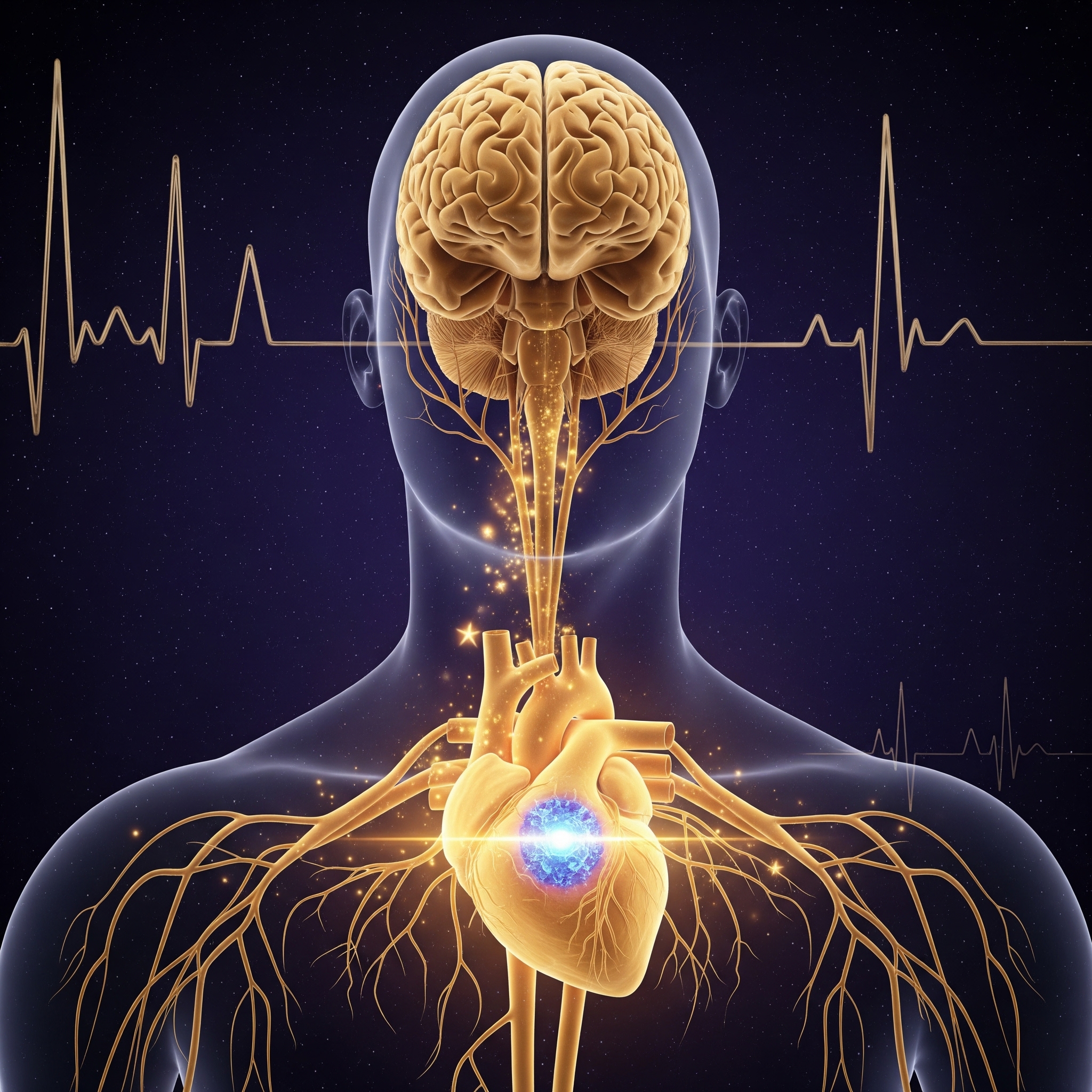How Stimulating Your Vagus Nerve Can Calm and Protect Your Heart
Deep within the intricate network of our nervous system lies a powerful, often overlooked conductor of health: the vagus nerve. Winding its way from the brainstem down through the neck and chest to the abdomen, this longest cranial nerve is the primary highway of the parasympathetic nervous system – our body’s “rest and digest” counterbalance to the stress-driven “fight or flight” response. Increasingly, research reveals that deliberately stimulating this nerve, known as vagal stimulation, holds remarkable potential for calming and protecting one of our most vital organs: the heart.
The Vagus Nerve: Your Heart’s Natural Brake Pedal
The heart doesn’t beat in isolation. Its rhythm and force are under constant, dynamic control by the autonomic nervous system. The sympathetic nervous system acts like an accelerator, revving up the heart rate and contractility during stress or exertion. The parasympathetic nervous system, chiefly via the vagus nerve, acts as the brake. When the vagus nerve fires, it releases acetylcholine onto the heart’s sinoatrial (SA) node (the natural pacemaker) and atrioventricular (AV) node.
-
Slowing the Beat: Acetylcholine directly hyperpolarizes the SA node cells, making it take longer for them to reach the threshold to fire an electrical impulse. This results in a slower heart rate (bradycardia).
-
Calming Excitability: It also slows conduction through the AV node, acting as a protective gatekeeper to prevent too many rapid atrial signals from overwhelming the ventricles.
-
Reducing Force: While less pronounced than its effect on rate, vagal stimulation can also slightly decrease the force of heart muscle contraction.
In essence, a healthy, active vagus nerve promotes heart rate variability (HRV) – the natural, healthy variation in the time interval between heartbeats. High HRV is a sign of a resilient, adaptable heart and nervous system, capable of efficiently responding to changing demands.
How Vagal Stimulation Directly Benefits Cardiac Health:
-
Combating Arrhythmias: Perhaps the most direct and clinically significant benefit lies in managing abnormal heart rhythms (arrhythmias). By slowing the SA node and dampening excessive electrical activity in the atria, vagal stimulation can:
-
Terminate Supraventricular Tachycardias (SVTs): Techniques like the Valsalva maneuver (forceful exhalation against a closed airway) or carotid sinus massage (gently massaging the neck – only performed by a clinician) work by acutely stimulating the vagus nerve to interrupt certain rapid rhythms originating above the ventricles.
-
Reduce Atrial Fibrillation (AFib) Burden: AFib, characterized by chaotic, rapid atrial contractions, is a major health concern. Studies suggest chronic vagus nerve stimulation (VNS), either implanted or transcutaneous (through the skin), may reduce the frequency, duration, and severity of AFib episodes. It appears to modulate the atrial tissue’s electrical properties and reduce inflammation, making it less prone to chaotic firing.
-
-
Lowering Heart Rate and Blood Pressure: Chronic stress keeps the sympathetic system dominant and vagal tone low, contributing to sustained high heart rate and hypertension – key risk factors for heart attack and stroke. By enhancing parasympathetic activity, vagal stimulation promotes vasodilation (widening of blood vessels) and lowers both resting heart rate and blood pressure over time, reducing the workload on the heart.
-
Reducing Inflammation: This is a crucial, less direct but profoundly important benefit. The vagus nerve possesses powerful anti-inflammatory pathways, often called the “cholinergic anti-inflammatory pathway.” When stimulated, it signals the release of neurotransmitters that dampen the production of pro-inflammatory cytokines (like TNF-alpha, IL-6). Chronic inflammation is a known driver of atherosclerosis (plaque buildup in arteries), heart failure, and the progression of conditions like AFib. By calming systemic inflammation, vagal stimulation helps protect the heart and blood vessels from inflammatory damage.
-
Improving Heart Rate Variability (HRV): As mentioned, robust HRV signifies a healthy, adaptable heart. Low HRV is associated with increased risk after a heart attack and overall cardiovascular mortality. Vagal stimulation, particularly chronic methods, has been shown to increase HRV, reflecting a restoration of healthier autonomic balance and greater cardiac resilience.
-
Potential in Heart Failure: While research is ongoing, there’s promising evidence suggesting VNS may benefit some patients with heart failure. By reducing heart rate, lowering sympathetic overdrive (a hallmark of worsening heart failure), modulating inflammation, and potentially improving the heart’s pumping efficiency, VNS offers a novel approach to managing this complex condition. Early clinical trials have shown mixed but encouraging results, particularly in improving quality of life and exercise capacity.
Methods of Vagal Stimulation:
-
Non-Invasive Techniques: These are accessible ways to naturally boost vagal tone:
-
Deep, Slow Diaphragmatic Breathing: Inhaling deeply through the nose, expanding the belly, and exhaling slowly (longer than the inhale) is perhaps the simplest and most effective method.
-
Cold Exposure: Brief cold showers or splashing the face with cold water triggers the “diving reflex,” which strongly stimulates the vagus nerve.
-
Humming, Chanting, or Singing: These activities vibrate the vocal cords, which are innervated by branches of the vagus nerve.
-
Meditation and Mindfulness: Practices focusing on calm awareness reliably increase parasympathetic activity and HRV.
-
Exercise: Moderate, regular exercise improves overall autonomic balance and vagal tone.
-
Social Connection and Laughter: Positive social interactions and genuine laughter stimulate vagal pathways.
-
-
Minimally Invasive/Transcutaneous: Devices like a small electrical stimulator worn on the ear (tVNS – transcutaneous Vagus Nerve Stimulation) deliver gentle electrical pulses to auricular branches of the vagus nerve.
-
Implanted Devices: Similar to devices used for epilepsy or depression, a small pulse generator is surgically implanted in the chest with a lead wrapped around the vagus nerve in the neck (iVNS – implanted Vagus Nerve Stimulation). This is used for specific, treatment-resistant cardiac conditions like refractory AFib under medical supervision.
The Future is Resonant
Vagal stimulation represents a paradigm shift, moving beyond solely targeting the heart itself to modulating the nervous system that controls it. It harnesses the body’s own innate healing and regulatory mechanisms. While implanted devices offer targeted therapy for specific conditions, the profound message is that we all possess powerful tools – breath, cold, sound, mindfulness, connection – to naturally nurture our vagal tone and, in turn, protect and calm our hearts.
By understanding and engaging this silent maestro within, we unlock a powerful pathway to cardiovascular resilience and long-term heart health. It’s a reminder that sometimes, the most effective medicine isn’t a pill or procedure, but the deliberate act of engaging our body’s own calming wisdom. Always consult with a healthcare professional before starting any new therapies, especially for existing heart conditions.






